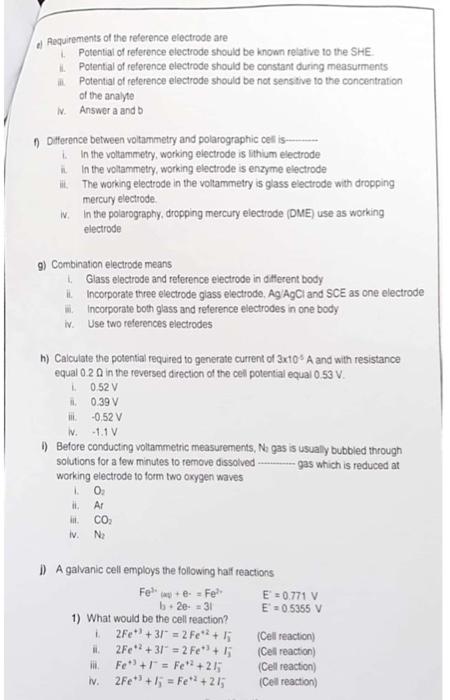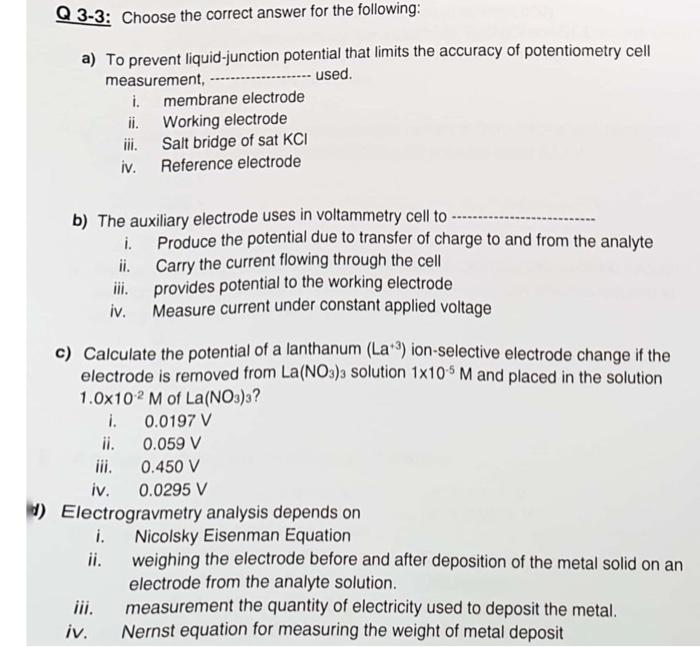multiple choice question .please this is 4 time i posted these question
please make solution without details except calculate question
thanks in advance
t) Aequirements of the reference electrode are. 1. Potential of reference electrode should be known relative to the SHE ii. Potential of reference electrode should be constant during measurments ii. Potential of relerence electrode should be not senstive to the concentration of the analyte iv. Answer a and b f) Diference between voltammetry and polarographic celt is. i. In the voltammetry, working electrode is lithium electrode i. In the volammetry, working electrode is enzyme electrode ii. The working electrode in the vollammetry is glass electrode with dropping mercury electrode. iv. In the polarography, dropping mercury electrode (DME) use as working electrode 9) Combination electrode means 1. Glass electrode and reference electrode in ditterent body ii. Incorporate three electrode glass electrode, AgAgCi and SCE as one electrode in. Incorporate both glass and reference electrodes in one body i. Use two references electrodes h) Calculate the potential required to generate current of 3105A and with resistance equal 0.2R in the reversed drection of the cell potential equal 0.53V. i. 0.52V i. 0.39V iii. 0,52V iv. 1.1V i) Before conducting voltammetric measurements, N. gas is usually bubbled through solutions for a few minutes to remove dissolved gas which is reduced at working electrode to form lwo oxygen waves i. O2 ii. Af iii. CO2 tv. N? j) A galvanic cell employs the following half reactions: Fe3(xy+e=Fe2E=0.771.Vb+2031E=0.5355V 1) What would be the cell reaction? i. 2Fe+3+3I=2Fe+2+I3(Cell reaction) i. 2Fe+2+3I=2Fe+3+I3 (Cell reaction) iii. Fe+3+I=Fe+2+2I3(Cell reaction) IV. 2Fe+3+I3=Fe+2+2I3 (Cell reaction) Q 3-3: Choose the correct answer for the following: a) To prevent liquid-junction potential that limits the accuracy of potentiometry cell measurement, i. membrane electrode ii. Working electrode iii. Salt bridge of sat KCl iv. Reference electrode b) The auxiliary electrode uses in voltammetry cell to i. Produce the potential due to transfer of charge to and from the analyte ii. Carry the current flowing through the cell iii. provides potential to the working electrode iv. Measure current under constant applied voltage c) Calculate the potential of a lanthanum (La+3) ion-selective electrode change if the electrode is removed from La(NO3)3 solution 110.5M and placed in the solution 1.0102M of La(NO3)3 ? i. 0.0197V ii. 0.059V iii. 0.450V iv. 0.0295V Electrogravmetry analysis depends on i. Nicolsky Eisenman Equation ii. weighing the electrode before and after deposition of the metal solid on an electrode from the analyte solution. iii. measurement the quantity of electricity used to deposit the metal. iv. Nernst equation for measuring the weight of metal deposit








